Business Law Assignment 3: Analysis of Australian Contract Law Cases
VerifiedAdded on 2021/06/17
|12
|2202
|54
Homework Assignment
AI Summary
This business law assignment analyzes several key areas of Australian contract law through a series of case studies. The assignment addresses issues of contract formation, including offer and acceptance, and determines whether a written agreement is binding. It also examines the doctrine of promissory estoppel, evaluating whether it applies in a given scenario. Furthermore, the assignment explores the concept of restraint of trade, analyzing the enforceability of such clauses in employment contracts. Finally, it delves into the application of contractual terms and conditions, specifically focusing on whether a party is entitled to a reward based on their knowledge of an offer. The assignment provides detailed legal reasoning and conclusions for each issue presented.
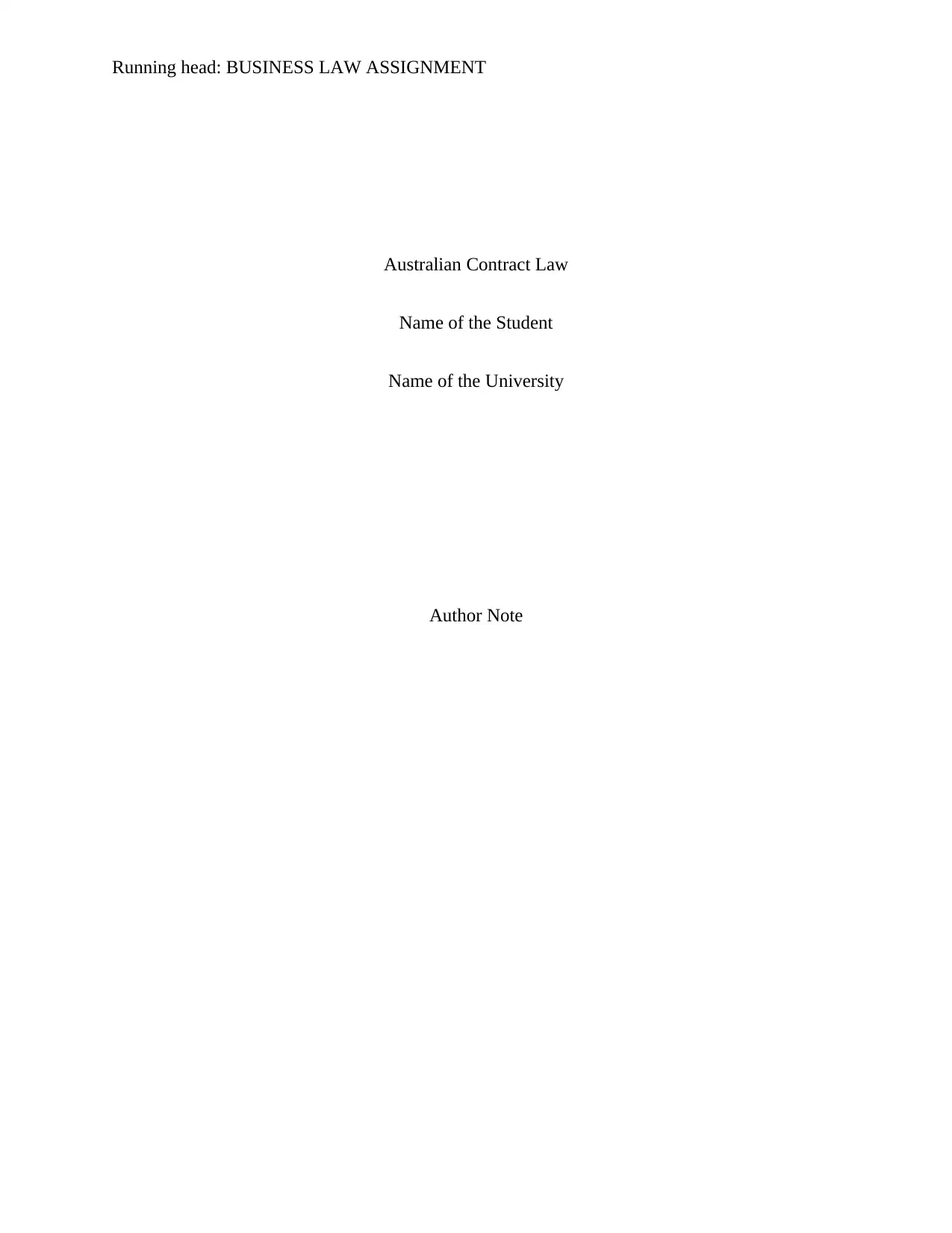
Running head: BUSINESS LAW ASSIGNMENT
Australian Contract Law
Name of the Student
Name of the University
Author Note
Australian Contract Law
Name of the Student
Name of the University
Author Note
Paraphrase This Document
Need a fresh take? Get an instant paraphrase of this document with our AI Paraphraser
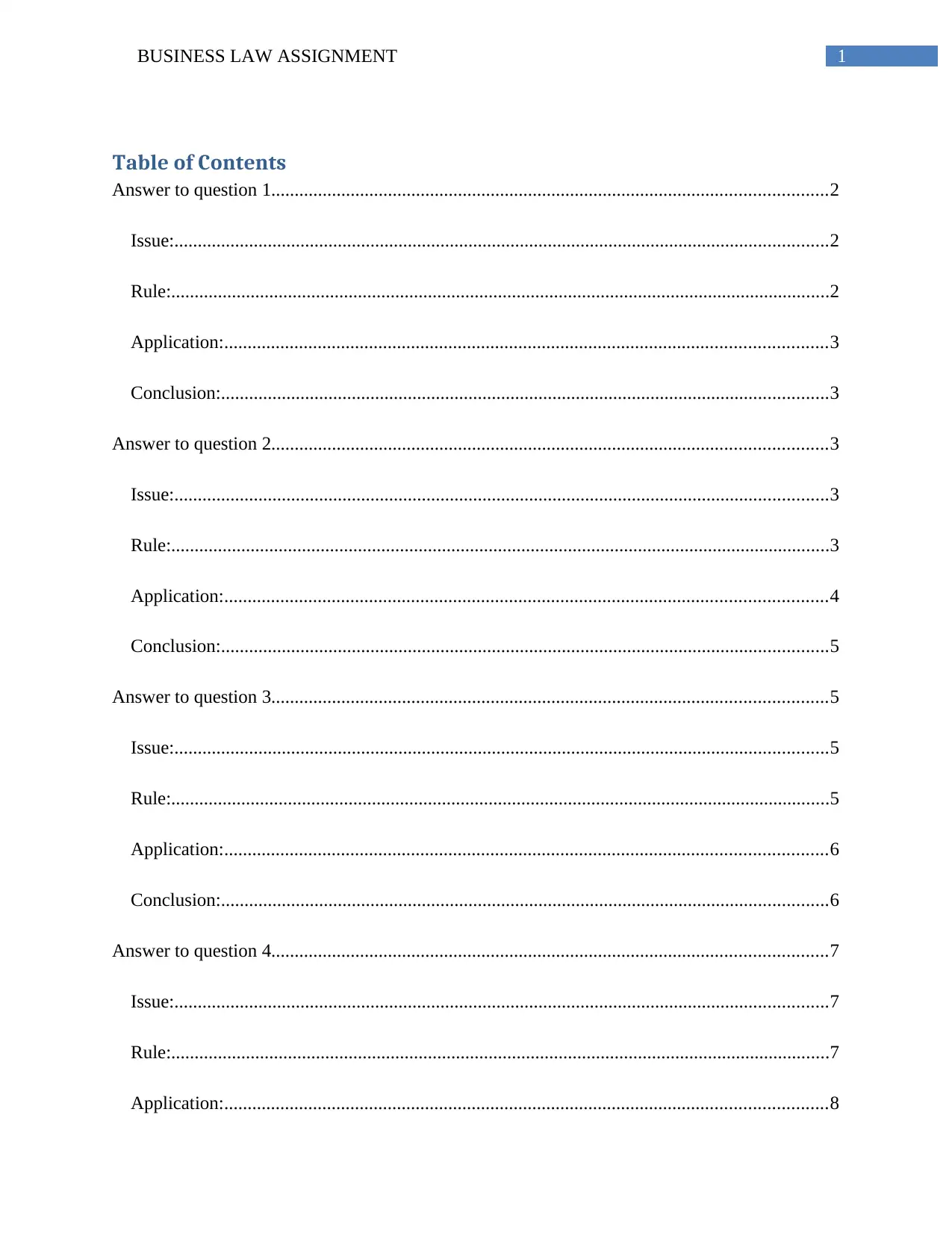
1BUSINESS LAW ASSIGNMENT
Table of Contents
Answer to question 1.......................................................................................................................2
Issue:............................................................................................................................................2
Rule:.............................................................................................................................................2
Application:.................................................................................................................................3
Conclusion:..................................................................................................................................3
Answer to question 2.......................................................................................................................3
Issue:............................................................................................................................................3
Rule:.............................................................................................................................................3
Application:.................................................................................................................................4
Conclusion:..................................................................................................................................5
Answer to question 3.......................................................................................................................5
Issue:............................................................................................................................................5
Rule:.............................................................................................................................................5
Application:.................................................................................................................................6
Conclusion:..................................................................................................................................6
Answer to question 4.......................................................................................................................7
Issue:............................................................................................................................................7
Rule:.............................................................................................................................................7
Application:.................................................................................................................................8
Table of Contents
Answer to question 1.......................................................................................................................2
Issue:............................................................................................................................................2
Rule:.............................................................................................................................................2
Application:.................................................................................................................................3
Conclusion:..................................................................................................................................3
Answer to question 2.......................................................................................................................3
Issue:............................................................................................................................................3
Rule:.............................................................................................................................................3
Application:.................................................................................................................................4
Conclusion:..................................................................................................................................5
Answer to question 3.......................................................................................................................5
Issue:............................................................................................................................................5
Rule:.............................................................................................................................................5
Application:.................................................................................................................................6
Conclusion:..................................................................................................................................6
Answer to question 4.......................................................................................................................7
Issue:............................................................................................................................................7
Rule:.............................................................................................................................................7
Application:.................................................................................................................................8

2BUSINESS LAW ASSIGNMENT
Conclusion:..................................................................................................................................8
Reference:........................................................................................................................................9
Conclusion:..................................................................................................................................8
Reference:........................................................................................................................................9
⊘ This is a preview!⊘
Do you want full access?
Subscribe today to unlock all pages.

Trusted by 1+ million students worldwide
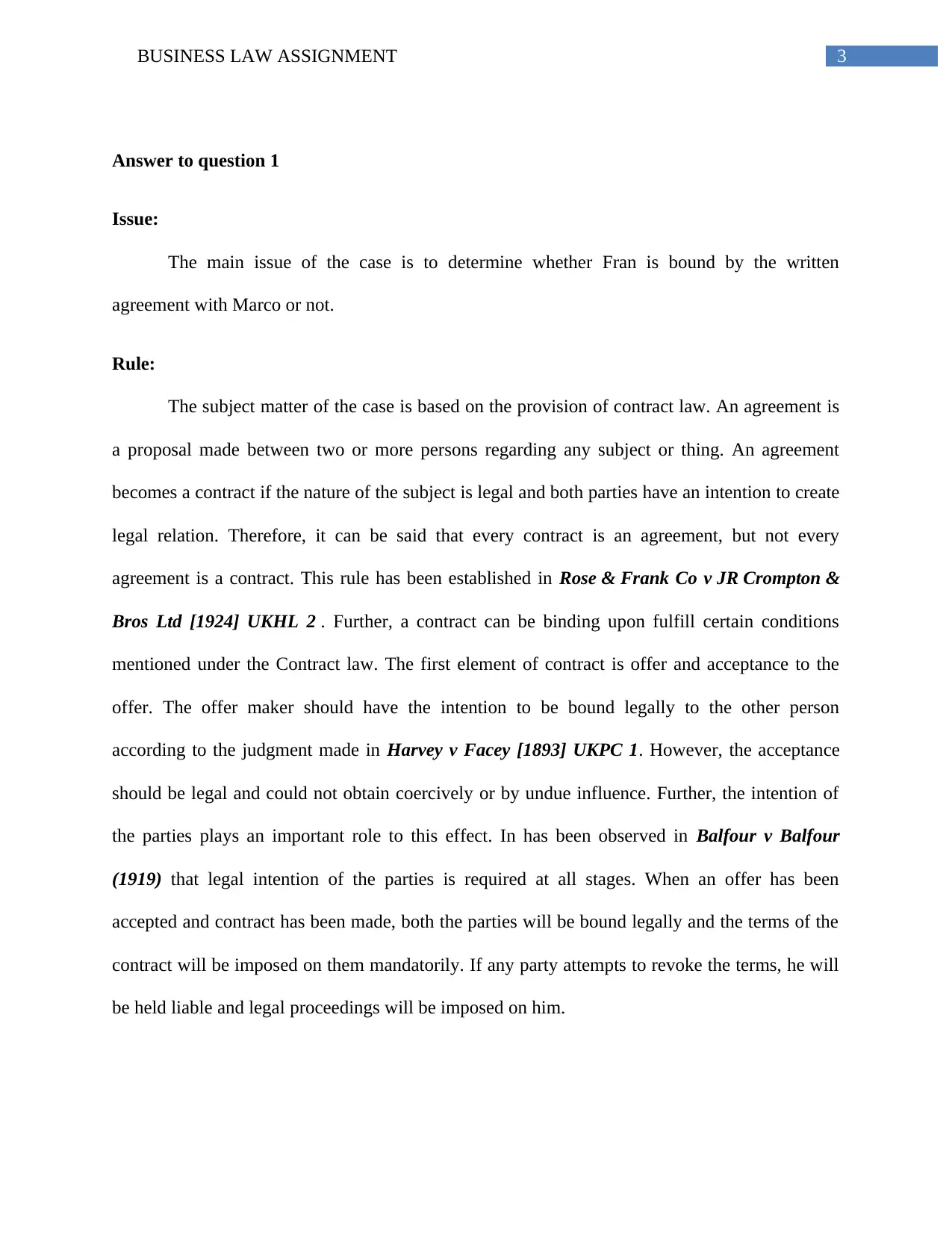
3BUSINESS LAW ASSIGNMENT
Answer to question 1
Issue:
The main issue of the case is to determine whether Fran is bound by the written
agreement with Marco or not.
Rule:
The subject matter of the case is based on the provision of contract law. An agreement is
a proposal made between two or more persons regarding any subject or thing. An agreement
becomes a contract if the nature of the subject is legal and both parties have an intention to create
legal relation. Therefore, it can be said that every contract is an agreement, but not every
agreement is a contract. This rule has been established in Rose & Frank Co v JR Crompton &
Bros Ltd [1924] UKHL 2 . Further, a contract can be binding upon fulfill certain conditions
mentioned under the Contract law. The first element of contract is offer and acceptance to the
offer. The offer maker should have the intention to be bound legally to the other person
according to the judgment made in Harvey v Facey [1893] UKPC 1. However, the acceptance
should be legal and could not obtain coercively or by undue influence. Further, the intention of
the parties plays an important role to this effect. In has been observed in Balfour v Balfour
(1919) that legal intention of the parties is required at all stages. When an offer has been
accepted and contract has been made, both the parties will be bound legally and the terms of the
contract will be imposed on them mandatorily. If any party attempts to revoke the terms, he will
be held liable and legal proceedings will be imposed on him.
Answer to question 1
Issue:
The main issue of the case is to determine whether Fran is bound by the written
agreement with Marco or not.
Rule:
The subject matter of the case is based on the provision of contract law. An agreement is
a proposal made between two or more persons regarding any subject or thing. An agreement
becomes a contract if the nature of the subject is legal and both parties have an intention to create
legal relation. Therefore, it can be said that every contract is an agreement, but not every
agreement is a contract. This rule has been established in Rose & Frank Co v JR Crompton &
Bros Ltd [1924] UKHL 2 . Further, a contract can be binding upon fulfill certain conditions
mentioned under the Contract law. The first element of contract is offer and acceptance to the
offer. The offer maker should have the intention to be bound legally to the other person
according to the judgment made in Harvey v Facey [1893] UKPC 1. However, the acceptance
should be legal and could not obtain coercively or by undue influence. Further, the intention of
the parties plays an important role to this effect. In has been observed in Balfour v Balfour
(1919) that legal intention of the parties is required at all stages. When an offer has been
accepted and contract has been made, both the parties will be bound legally and the terms of the
contract will be imposed on them mandatorily. If any party attempts to revoke the terms, he will
be held liable and legal proceedings will be imposed on him.
Paraphrase This Document
Need a fresh take? Get an instant paraphrase of this document with our AI Paraphraser
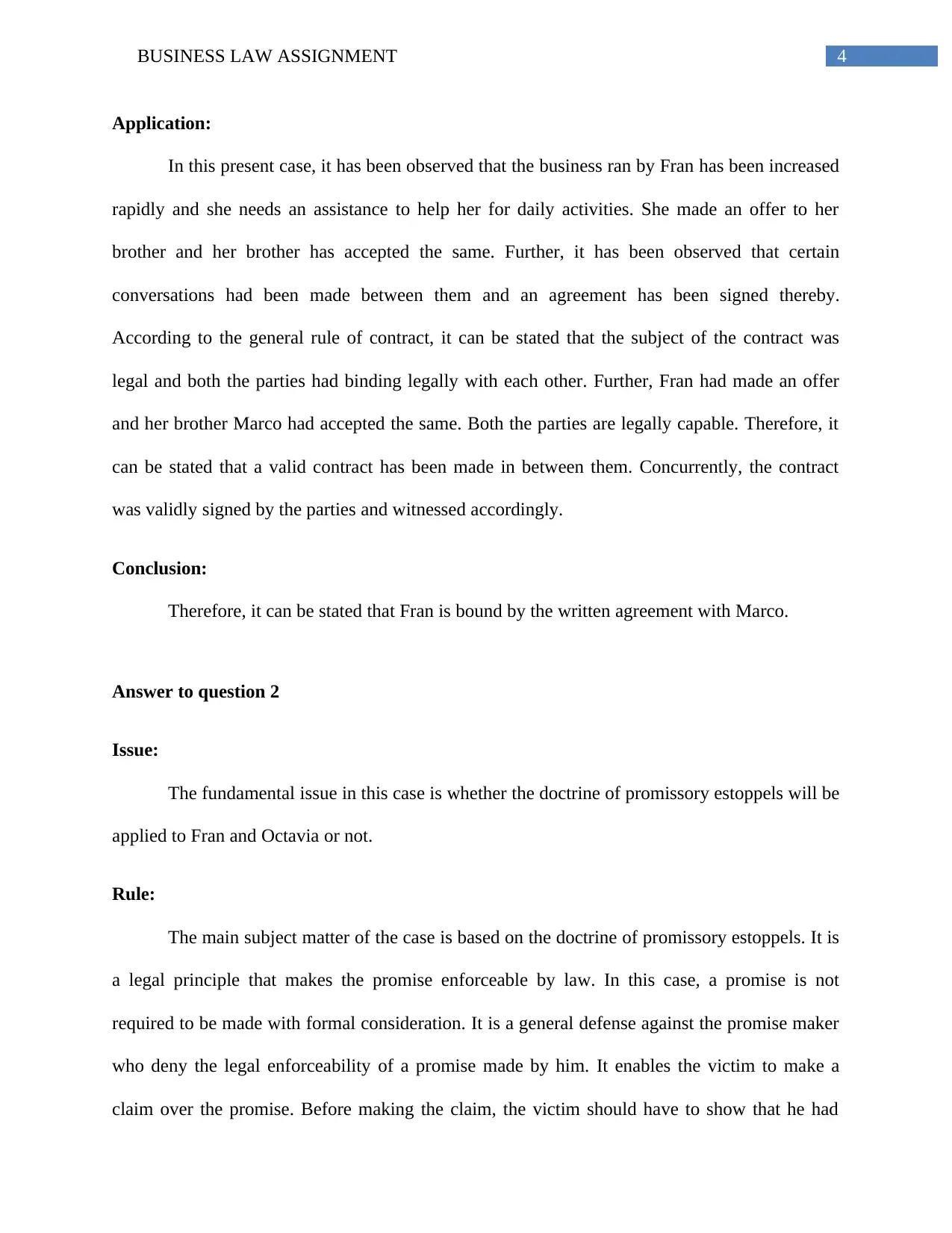
4BUSINESS LAW ASSIGNMENT
Application:
In this present case, it has been observed that the business ran by Fran has been increased
rapidly and she needs an assistance to help her for daily activities. She made an offer to her
brother and her brother has accepted the same. Further, it has been observed that certain
conversations had been made between them and an agreement has been signed thereby.
According to the general rule of contract, it can be stated that the subject of the contract was
legal and both the parties had binding legally with each other. Further, Fran had made an offer
and her brother Marco had accepted the same. Both the parties are legally capable. Therefore, it
can be stated that a valid contract has been made in between them. Concurrently, the contract
was validly signed by the parties and witnessed accordingly.
Conclusion:
Therefore, it can be stated that Fran is bound by the written agreement with Marco.
Answer to question 2
Issue:
The fundamental issue in this case is whether the doctrine of promissory estoppels will be
applied to Fran and Octavia or not.
Rule:
The main subject matter of the case is based on the doctrine of promissory estoppels. It is
a legal principle that makes the promise enforceable by law. In this case, a promise is not
required to be made with formal consideration. It is a general defense against the promise maker
who deny the legal enforceability of a promise made by him. It enables the victim to make a
claim over the promise. Before making the claim, the victim should have to show that he had
Application:
In this present case, it has been observed that the business ran by Fran has been increased
rapidly and she needs an assistance to help her for daily activities. She made an offer to her
brother and her brother has accepted the same. Further, it has been observed that certain
conversations had been made between them and an agreement has been signed thereby.
According to the general rule of contract, it can be stated that the subject of the contract was
legal and both the parties had binding legally with each other. Further, Fran had made an offer
and her brother Marco had accepted the same. Both the parties are legally capable. Therefore, it
can be stated that a valid contract has been made in between them. Concurrently, the contract
was validly signed by the parties and witnessed accordingly.
Conclusion:
Therefore, it can be stated that Fran is bound by the written agreement with Marco.
Answer to question 2
Issue:
The fundamental issue in this case is whether the doctrine of promissory estoppels will be
applied to Fran and Octavia or not.
Rule:
The main subject matter of the case is based on the doctrine of promissory estoppels. It is
a legal principle that makes the promise enforceable by law. In this case, a promise is not
required to be made with formal consideration. It is a general defense against the promise maker
who deny the legal enforceability of a promise made by him. It enables the victim to make a
claim over the promise. Before making the claim, the victim should have to show that he had
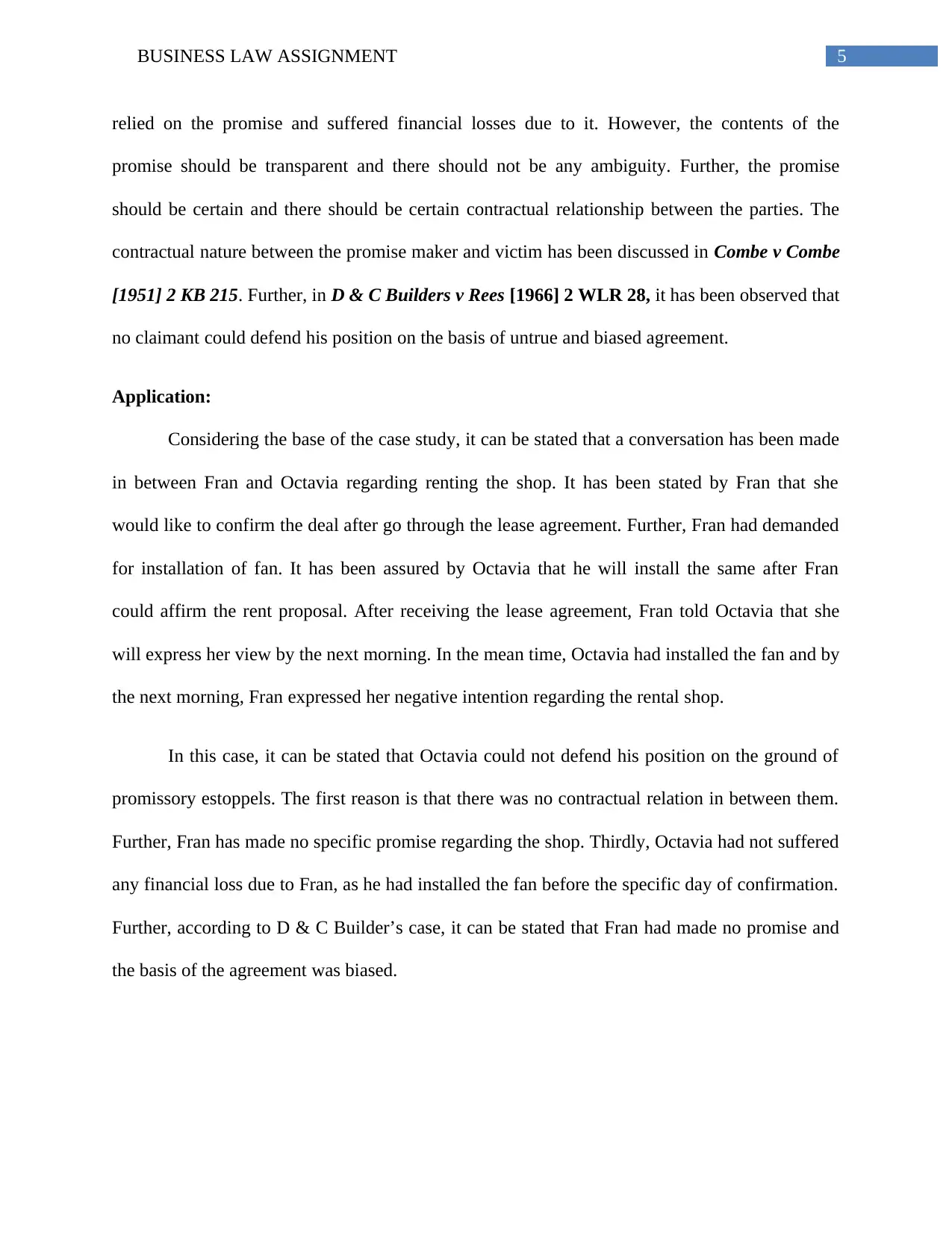
5BUSINESS LAW ASSIGNMENT
relied on the promise and suffered financial losses due to it. However, the contents of the
promise should be transparent and there should not be any ambiguity. Further, the promise
should be certain and there should be certain contractual relationship between the parties. The
contractual nature between the promise maker and victim has been discussed in Combe v Combe
[1951] 2 KB 215. Further, in D & C Builders v Rees [1966] 2 WLR 28, it has been observed that
no claimant could defend his position on the basis of untrue and biased agreement.
Application:
Considering the base of the case study, it can be stated that a conversation has been made
in between Fran and Octavia regarding renting the shop. It has been stated by Fran that she
would like to confirm the deal after go through the lease agreement. Further, Fran had demanded
for installation of fan. It has been assured by Octavia that he will install the same after Fran
could affirm the rent proposal. After receiving the lease agreement, Fran told Octavia that she
will express her view by the next morning. In the mean time, Octavia had installed the fan and by
the next morning, Fran expressed her negative intention regarding the rental shop.
In this case, it can be stated that Octavia could not defend his position on the ground of
promissory estoppels. The first reason is that there was no contractual relation in between them.
Further, Fran has made no specific promise regarding the shop. Thirdly, Octavia had not suffered
any financial loss due to Fran, as he had installed the fan before the specific day of confirmation.
Further, according to D & C Builder’s case, it can be stated that Fran had made no promise and
the basis of the agreement was biased.
relied on the promise and suffered financial losses due to it. However, the contents of the
promise should be transparent and there should not be any ambiguity. Further, the promise
should be certain and there should be certain contractual relationship between the parties. The
contractual nature between the promise maker and victim has been discussed in Combe v Combe
[1951] 2 KB 215. Further, in D & C Builders v Rees [1966] 2 WLR 28, it has been observed that
no claimant could defend his position on the basis of untrue and biased agreement.
Application:
Considering the base of the case study, it can be stated that a conversation has been made
in between Fran and Octavia regarding renting the shop. It has been stated by Fran that she
would like to confirm the deal after go through the lease agreement. Further, Fran had demanded
for installation of fan. It has been assured by Octavia that he will install the same after Fran
could affirm the rent proposal. After receiving the lease agreement, Fran told Octavia that she
will express her view by the next morning. In the mean time, Octavia had installed the fan and by
the next morning, Fran expressed her negative intention regarding the rental shop.
In this case, it can be stated that Octavia could not defend his position on the ground of
promissory estoppels. The first reason is that there was no contractual relation in between them.
Further, Fran has made no specific promise regarding the shop. Thirdly, Octavia had not suffered
any financial loss due to Fran, as he had installed the fan before the specific day of confirmation.
Further, according to D & C Builder’s case, it can be stated that Fran had made no promise and
the basis of the agreement was biased.
⊘ This is a preview!⊘
Do you want full access?
Subscribe today to unlock all pages.

Trusted by 1+ million students worldwide
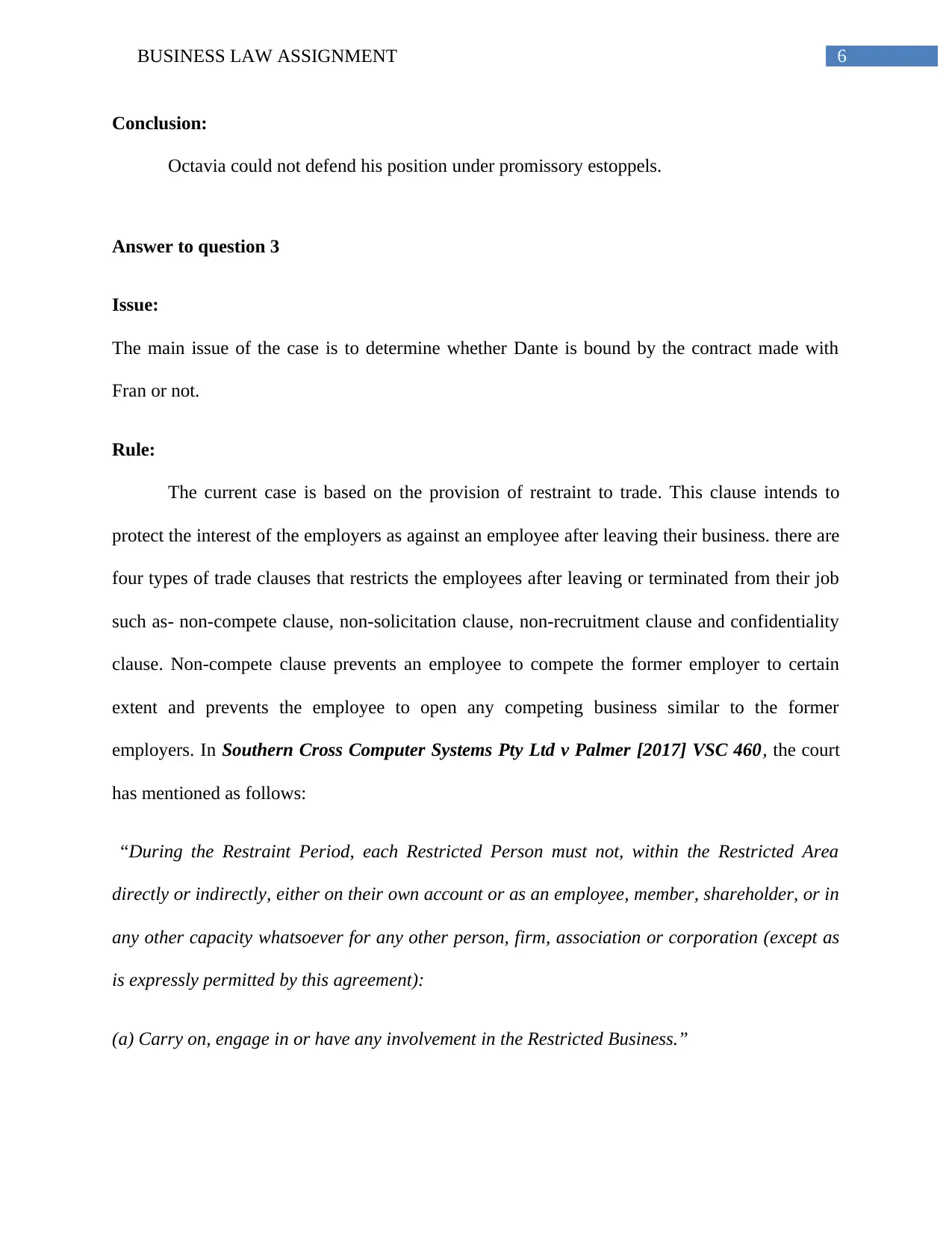
6BUSINESS LAW ASSIGNMENT
Conclusion:
Octavia could not defend his position under promissory estoppels.
Answer to question 3
Issue:
The main issue of the case is to determine whether Dante is bound by the contract made with
Fran or not.
Rule:
The current case is based on the provision of restraint to trade. This clause intends to
protect the interest of the employers as against an employee after leaving their business. there are
four types of trade clauses that restricts the employees after leaving or terminated from their job
such as- non-compete clause, non-solicitation clause, non-recruitment clause and confidentiality
clause. Non-compete clause prevents an employee to compete the former employer to certain
extent and prevents the employee to open any competing business similar to the former
employers. In Southern Cross Computer Systems Pty Ltd v Palmer [2017] VSC 460, the court
has mentioned as follows:
“During the Restraint Period, each Restricted Person must not, within the Restricted Area
directly or indirectly, either on their own account or as an employee, member, shareholder, or in
any other capacity whatsoever for any other person, firm, association or corporation (except as
is expressly permitted by this agreement):
(a) Carry on, engage in or have any involvement in the Restricted Business.”
Conclusion:
Octavia could not defend his position under promissory estoppels.
Answer to question 3
Issue:
The main issue of the case is to determine whether Dante is bound by the contract made with
Fran or not.
Rule:
The current case is based on the provision of restraint to trade. This clause intends to
protect the interest of the employers as against an employee after leaving their business. there are
four types of trade clauses that restricts the employees after leaving or terminated from their job
such as- non-compete clause, non-solicitation clause, non-recruitment clause and confidentiality
clause. Non-compete clause prevents an employee to compete the former employer to certain
extent and prevents the employee to open any competing business similar to the former
employers. In Southern Cross Computer Systems Pty Ltd v Palmer [2017] VSC 460, the court
has mentioned as follows:
“During the Restraint Period, each Restricted Person must not, within the Restricted Area
directly or indirectly, either on their own account or as an employee, member, shareholder, or in
any other capacity whatsoever for any other person, firm, association or corporation (except as
is expressly permitted by this agreement):
(a) Carry on, engage in or have any involvement in the Restricted Business.”
Paraphrase This Document
Need a fresh take? Get an instant paraphrase of this document with our AI Paraphraser
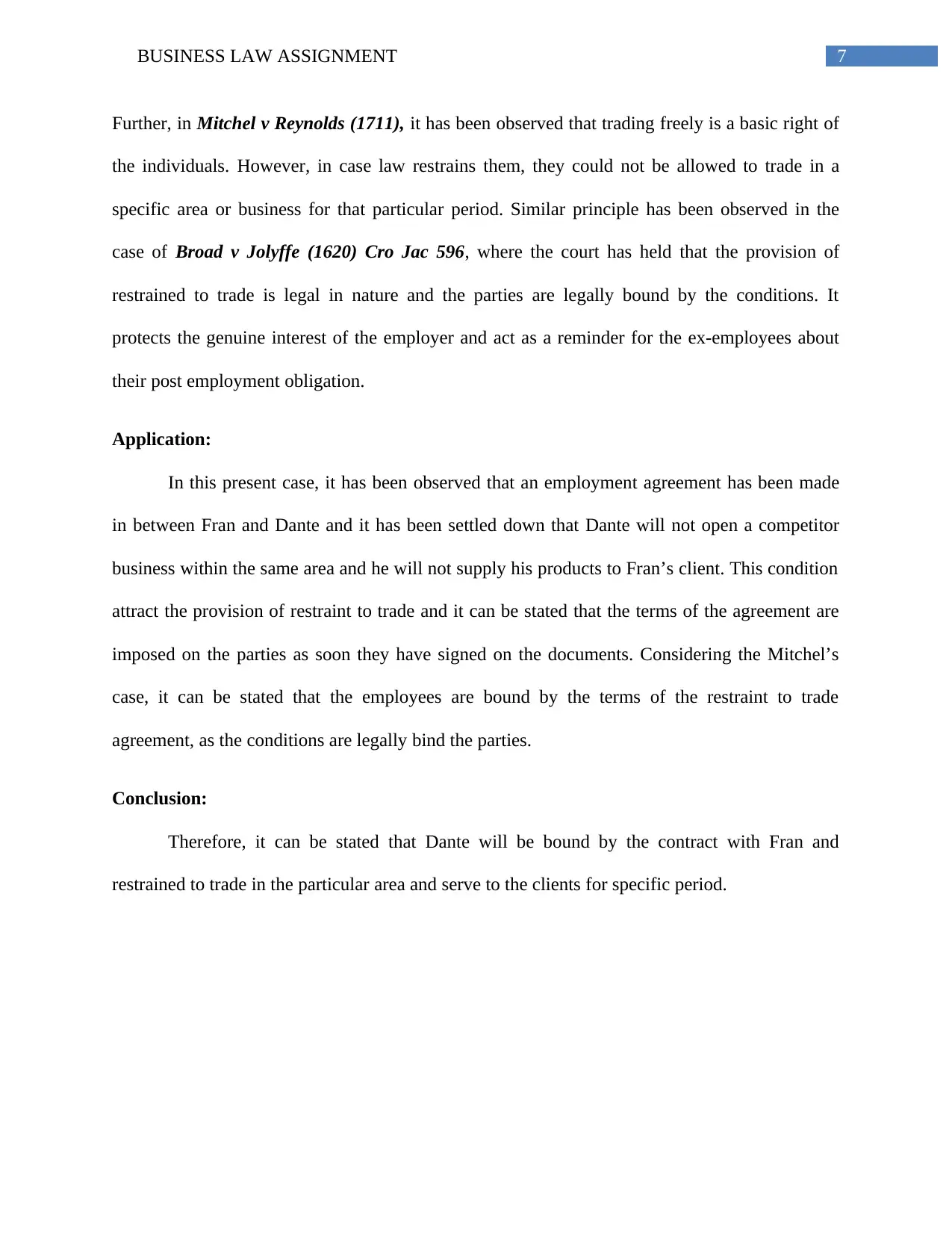
7BUSINESS LAW ASSIGNMENT
Further, in Mitchel v Reynolds (1711), it has been observed that trading freely is a basic right of
the individuals. However, in case law restrains them, they could not be allowed to trade in a
specific area or business for that particular period. Similar principle has been observed in the
case of Broad v Jolyffe (1620) Cro Jac 596, where the court has held that the provision of
restrained to trade is legal in nature and the parties are legally bound by the conditions. It
protects the genuine interest of the employer and act as a reminder for the ex-employees about
their post employment obligation.
Application:
In this present case, it has been observed that an employment agreement has been made
in between Fran and Dante and it has been settled down that Dante will not open a competitor
business within the same area and he will not supply his products to Fran’s client. This condition
attract the provision of restraint to trade and it can be stated that the terms of the agreement are
imposed on the parties as soon they have signed on the documents. Considering the Mitchel’s
case, it can be stated that the employees are bound by the terms of the restraint to trade
agreement, as the conditions are legally bind the parties.
Conclusion:
Therefore, it can be stated that Dante will be bound by the contract with Fran and
restrained to trade in the particular area and serve to the clients for specific period.
Further, in Mitchel v Reynolds (1711), it has been observed that trading freely is a basic right of
the individuals. However, in case law restrains them, they could not be allowed to trade in a
specific area or business for that particular period. Similar principle has been observed in the
case of Broad v Jolyffe (1620) Cro Jac 596, where the court has held that the provision of
restrained to trade is legal in nature and the parties are legally bound by the conditions. It
protects the genuine interest of the employer and act as a reminder for the ex-employees about
their post employment obligation.
Application:
In this present case, it has been observed that an employment agreement has been made
in between Fran and Dante and it has been settled down that Dante will not open a competitor
business within the same area and he will not supply his products to Fran’s client. This condition
attract the provision of restraint to trade and it can be stated that the terms of the agreement are
imposed on the parties as soon they have signed on the documents. Considering the Mitchel’s
case, it can be stated that the employees are bound by the terms of the restraint to trade
agreement, as the conditions are legally bind the parties.
Conclusion:
Therefore, it can be stated that Dante will be bound by the contract with Fran and
restrained to trade in the particular area and serve to the clients for specific period.
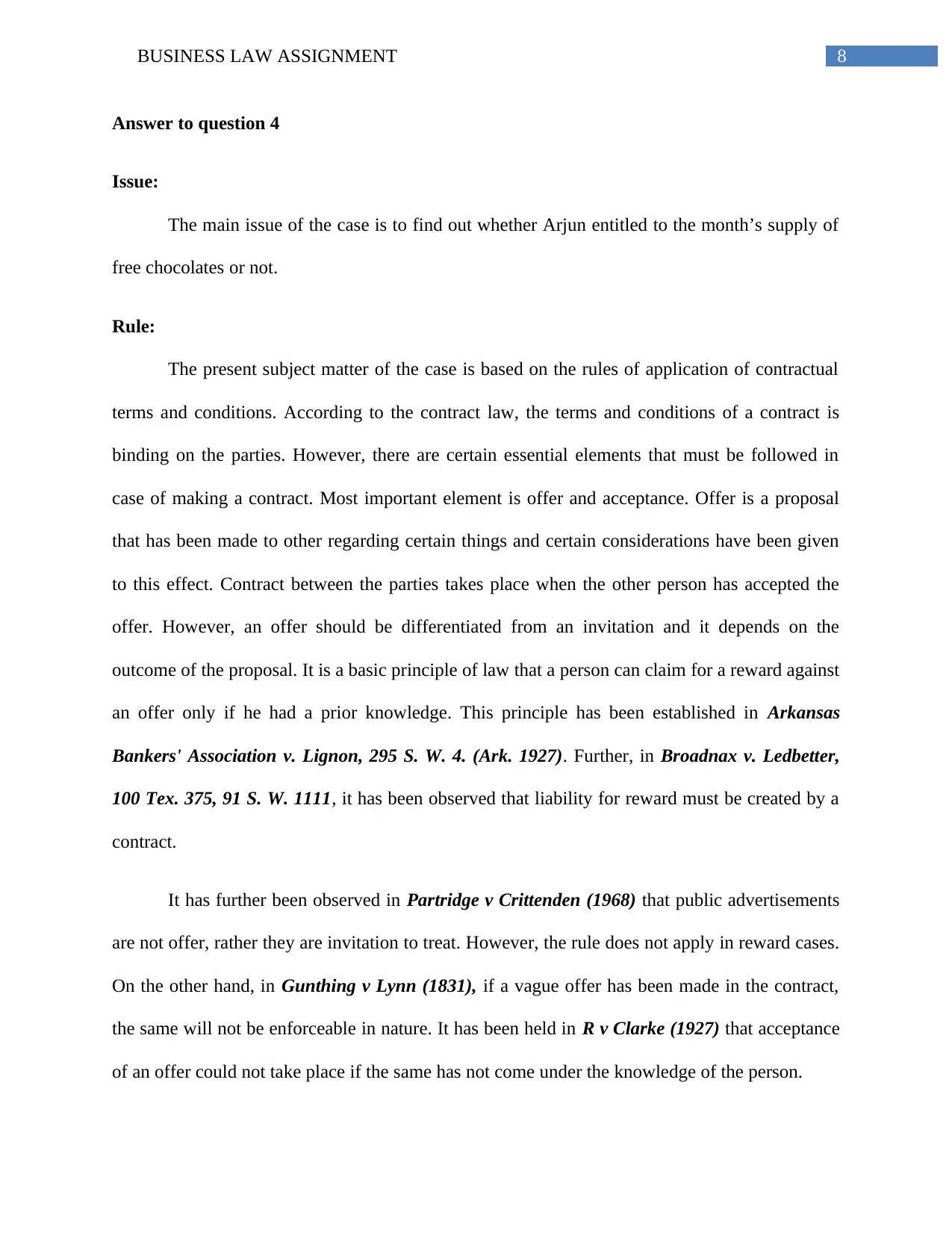
8BUSINESS LAW ASSIGNMENT
Answer to question 4
Issue:
The main issue of the case is to find out whether Arjun entitled to the month’s supply of
free chocolates or not.
Rule:
The present subject matter of the case is based on the rules of application of contractual
terms and conditions. According to the contract law, the terms and conditions of a contract is
binding on the parties. However, there are certain essential elements that must be followed in
case of making a contract. Most important element is offer and acceptance. Offer is a proposal
that has been made to other regarding certain things and certain considerations have been given
to this effect. Contract between the parties takes place when the other person has accepted the
offer. However, an offer should be differentiated from an invitation and it depends on the
outcome of the proposal. It is a basic principle of law that a person can claim for a reward against
an offer only if he had a prior knowledge. This principle has been established in Arkansas
Bankers' Association v. Lignon, 295 S. W. 4. (Ark. 1927). Further, in Broadnax v. Ledbetter,
100 Tex. 375, 91 S. W. 1111, it has been observed that liability for reward must be created by a
contract.
It has further been observed in Partridge v Crittenden (1968) that public advertisements
are not offer, rather they are invitation to treat. However, the rule does not apply in reward cases.
On the other hand, in Gunthing v Lynn (1831), if a vague offer has been made in the contract,
the same will not be enforceable in nature. It has been held in R v Clarke (1927) that acceptance
of an offer could not take place if the same has not come under the knowledge of the person.
Answer to question 4
Issue:
The main issue of the case is to find out whether Arjun entitled to the month’s supply of
free chocolates or not.
Rule:
The present subject matter of the case is based on the rules of application of contractual
terms and conditions. According to the contract law, the terms and conditions of a contract is
binding on the parties. However, there are certain essential elements that must be followed in
case of making a contract. Most important element is offer and acceptance. Offer is a proposal
that has been made to other regarding certain things and certain considerations have been given
to this effect. Contract between the parties takes place when the other person has accepted the
offer. However, an offer should be differentiated from an invitation and it depends on the
outcome of the proposal. It is a basic principle of law that a person can claim for a reward against
an offer only if he had a prior knowledge. This principle has been established in Arkansas
Bankers' Association v. Lignon, 295 S. W. 4. (Ark. 1927). Further, in Broadnax v. Ledbetter,
100 Tex. 375, 91 S. W. 1111, it has been observed that liability for reward must be created by a
contract.
It has further been observed in Partridge v Crittenden (1968) that public advertisements
are not offer, rather they are invitation to treat. However, the rule does not apply in reward cases.
On the other hand, in Gunthing v Lynn (1831), if a vague offer has been made in the contract,
the same will not be enforceable in nature. It has been held in R v Clarke (1927) that acceptance
of an offer could not take place if the same has not come under the knowledge of the person.
⊘ This is a preview!⊘
Do you want full access?
Subscribe today to unlock all pages.

Trusted by 1+ million students worldwide
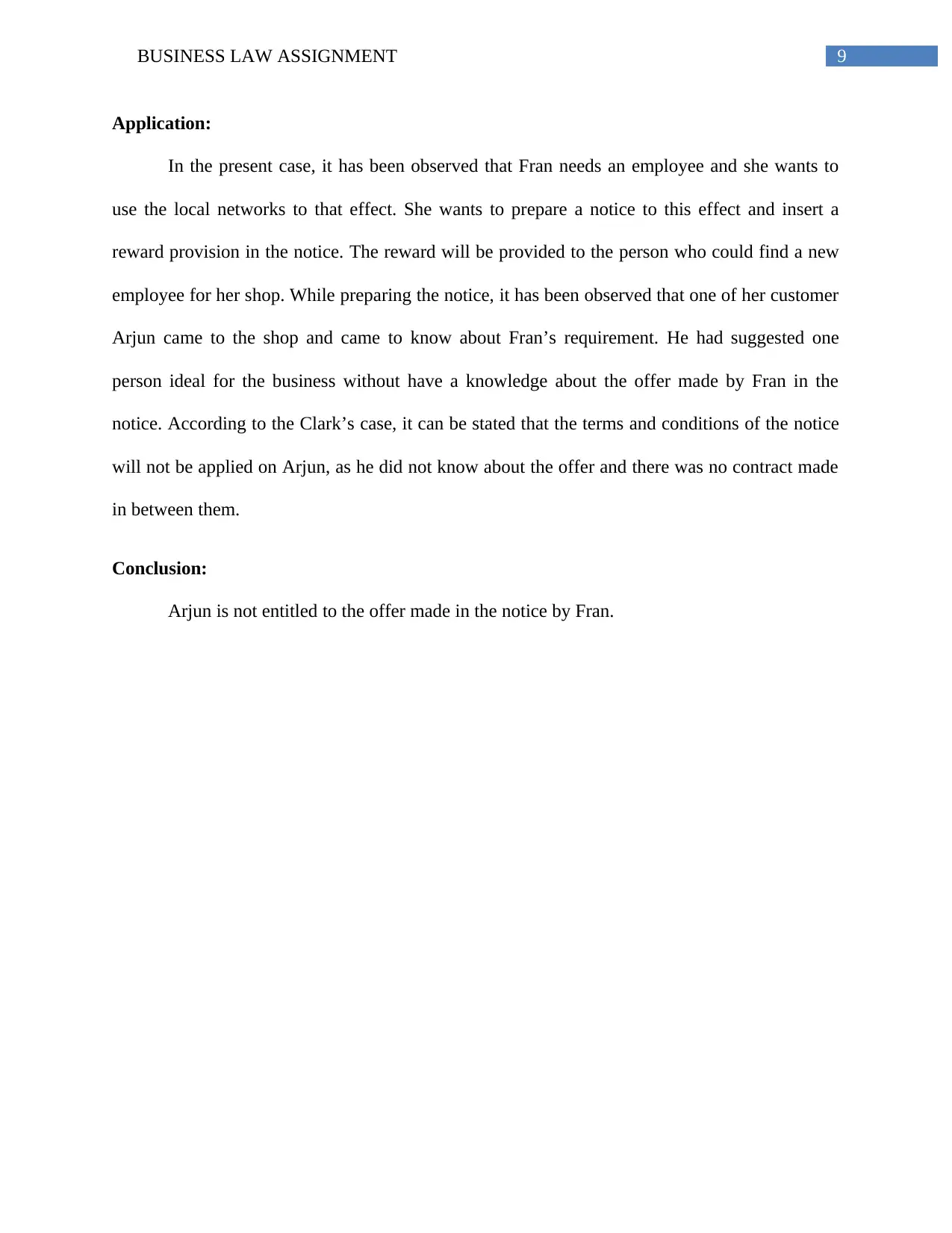
9BUSINESS LAW ASSIGNMENT
Application:
In the present case, it has been observed that Fran needs an employee and she wants to
use the local networks to that effect. She wants to prepare a notice to this effect and insert a
reward provision in the notice. The reward will be provided to the person who could find a new
employee for her shop. While preparing the notice, it has been observed that one of her customer
Arjun came to the shop and came to know about Fran’s requirement. He had suggested one
person ideal for the business without have a knowledge about the offer made by Fran in the
notice. According to the Clark’s case, it can be stated that the terms and conditions of the notice
will not be applied on Arjun, as he did not know about the offer and there was no contract made
in between them.
Conclusion:
Arjun is not entitled to the offer made in the notice by Fran.
Application:
In the present case, it has been observed that Fran needs an employee and she wants to
use the local networks to that effect. She wants to prepare a notice to this effect and insert a
reward provision in the notice. The reward will be provided to the person who could find a new
employee for her shop. While preparing the notice, it has been observed that one of her customer
Arjun came to the shop and came to know about Fran’s requirement. He had suggested one
person ideal for the business without have a knowledge about the offer made by Fran in the
notice. According to the Clark’s case, it can be stated that the terms and conditions of the notice
will not be applied on Arjun, as he did not know about the offer and there was no contract made
in between them.
Conclusion:
Arjun is not entitled to the offer made in the notice by Fran.
Paraphrase This Document
Need a fresh take? Get an instant paraphrase of this document with our AI Paraphraser
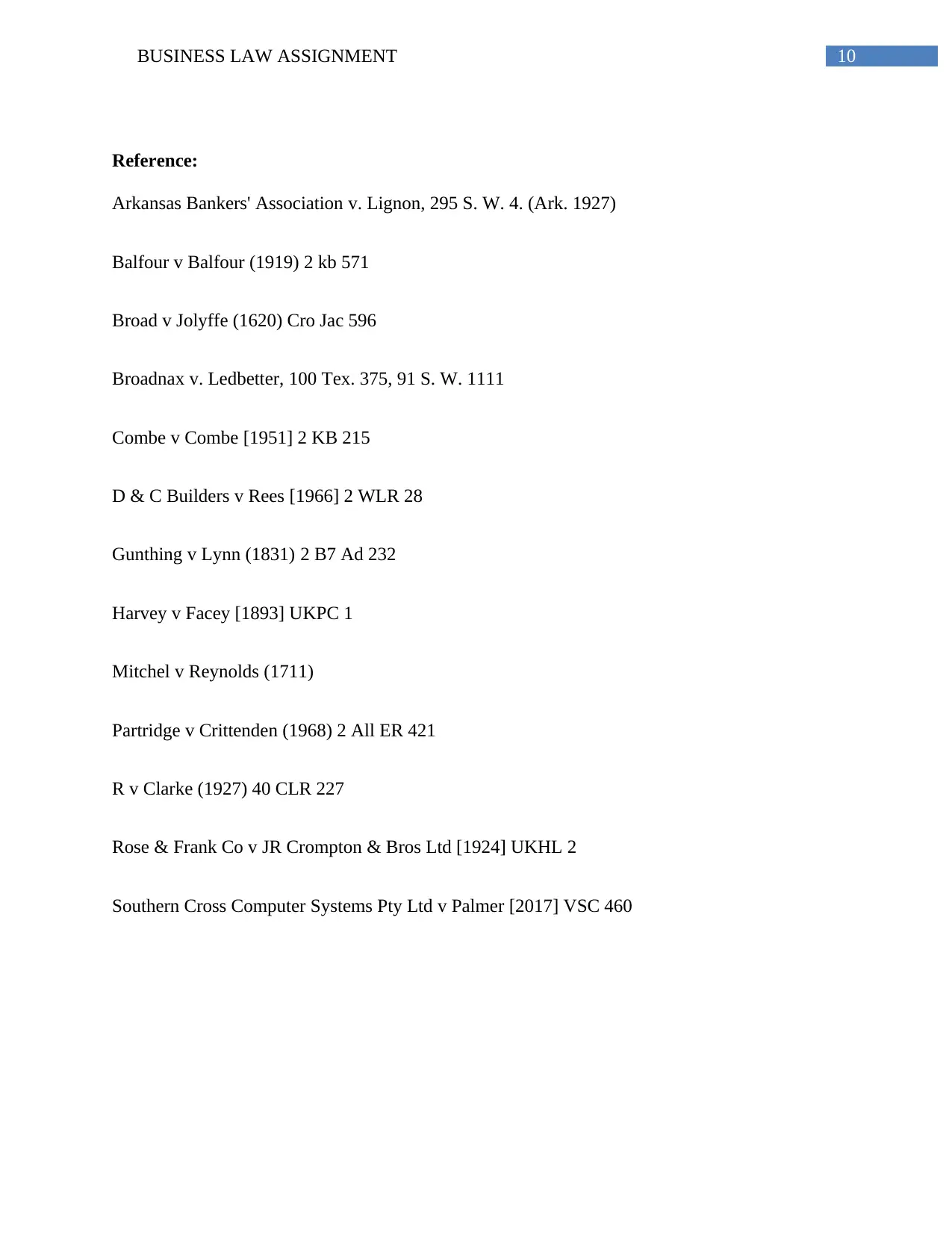
10BUSINESS LAW ASSIGNMENT
Reference:
Arkansas Bankers' Association v. Lignon, 295 S. W. 4. (Ark. 1927)
Balfour v Balfour (1919) 2 kb 571
Broad v Jolyffe (1620) Cro Jac 596
Broadnax v. Ledbetter, 100 Tex. 375, 91 S. W. 1111
Combe v Combe [1951] 2 KB 215
D & C Builders v Rees [1966] 2 WLR 28
Gunthing v Lynn (1831) 2 B7 Ad 232
Harvey v Facey [1893] UKPC 1
Mitchel v Reynolds (1711)
Partridge v Crittenden (1968) 2 All ER 421
R v Clarke (1927) 40 CLR 227
Rose & Frank Co v JR Crompton & Bros Ltd [1924] UKHL 2
Southern Cross Computer Systems Pty Ltd v Palmer [2017] VSC 460
Reference:
Arkansas Bankers' Association v. Lignon, 295 S. W. 4. (Ark. 1927)
Balfour v Balfour (1919) 2 kb 571
Broad v Jolyffe (1620) Cro Jac 596
Broadnax v. Ledbetter, 100 Tex. 375, 91 S. W. 1111
Combe v Combe [1951] 2 KB 215
D & C Builders v Rees [1966] 2 WLR 28
Gunthing v Lynn (1831) 2 B7 Ad 232
Harvey v Facey [1893] UKPC 1
Mitchel v Reynolds (1711)
Partridge v Crittenden (1968) 2 All ER 421
R v Clarke (1927) 40 CLR 227
Rose & Frank Co v JR Crompton & Bros Ltd [1924] UKHL 2
Southern Cross Computer Systems Pty Ltd v Palmer [2017] VSC 460

11BUSINESS LAW ASSIGNMENT
⊘ This is a preview!⊘
Do you want full access?
Subscribe today to unlock all pages.

Trusted by 1+ million students worldwide
1 out of 12
Related Documents
Your All-in-One AI-Powered Toolkit for Academic Success.
+13062052269
info@desklib.com
Available 24*7 on WhatsApp / Email
![[object Object]](/_next/static/media/star-bottom.7253800d.svg)
Unlock your academic potential
Copyright © 2020–2025 A2Z Services. All Rights Reserved. Developed and managed by ZUCOL.

